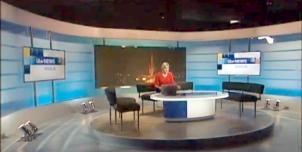Full Freeview on the Sudbury (Suffolk, England) transmitter
| Google Streetview | Google map | Bing map | Google Earth | 52.005,0.786 or 52°0'17"N 0°47'8"E | CO10 5NG |
The symbol shows the location of the Sudbury (Suffolk, England) transmitter which serves 440,000 homes. The bright green areas shown where the signal from this transmitter is strong, dark green areas are poorer signals. Those parts shown in yellow may have interference on the same frequency from other masts.
This transmitter has no current reported problems
The BBC and Digital UK report there are no faults or engineering work on the Sudbury (Suffolk, England) transmitter._______
Digital television services are broadcast on a multiplexes (or Mux) where many stations occupy a single broadcast frequency, as shown below.
64QAM 8K 3/4 27.1Mb/s DVB-T MPEG2
H/V: aerial position (horizontal or vertical)
The Sudbury (Suffolk, England) mast is a public service broadcasting (PSB) transmitter, it does not provide these commercial (COM) channels: .
If you want to watch these channels, your aerial must point to one of the 80 Full service Freeview transmitters. For more information see the will there ever be more services on the Freeview Light transmitters? page.
Which Freeview channels does the Sudbury transmitter broadcast?
If you have any kind of Freeview fault, follow this Freeview reset procedure first.Digital television services are broadcast on a multiplexes (or Mux) where many stations occupy a single broadcast frequency, as shown below.
64QAM 8K 3/4 27.1Mb/s DVB-T MPEG2
H/V: aerial position (horizontal or vertical)
The Sudbury (Suffolk, England) mast is a public service broadcasting (PSB) transmitter, it does not provide these commercial (COM) channels: .
If you want to watch these channels, your aerial must point to one of the 80 Full service Freeview transmitters. For more information see the will there ever be more services on the Freeview Light transmitters? page.
Which BBC and ITV regional news can I watch from the Sudbury transmitter?

BBC Look East (East) 0.8m homes 3.2%
from Norwich NR2 1BH, 77km north-northeast (24°)
to BBC East region - 27 masts.
70% of BBC East (East) and BBC East (West) is shared output

ITV Anglia News 0.8m homes 3.2%
from NORWICH NR1 3JG, 78km north-northeast (24°)
to ITV Anglia (East) region - 26 masts.
All of lunch, weekend and 80% evening news is shared with Anglia (West)
Are there any self-help relays?
| Felixstowe West | Transposer | 1000 homes +1000 or more homes due to expansion of affected area? | |
| Witham | Transposer | 14 km NE Chelmsford. | 118 homes |
How will the Sudbury (Suffolk, England) transmission frequencies change over time?
| 1984-97 | 1997-98 | 1998-2011 | 2011-13 | 1 Aug 2018 | |||||
| B E T | B E T | B E T | E T | K T | |||||
| C29 | SDN | ||||||||
| C31 | ArqA | ||||||||
| C35 | C5waves | C5waves | |||||||
| C37 | ArqB | ||||||||
| C41 | ITVwaves | ITVwaves | ITVwaves | D3+4 | D3+4 | ||||
| C44 | BBC2waves | BBC2waves | BBC2waves | BBCA | BBCA | ||||
| C47 | C4waves | C4waves | C4waves | BBCB | BBCB | ||||
| C51tv_off | BBC1waves | BBC1waves | BBC1waves | ||||||
| C56tv_off | ArqB | ||||||||
| C58tv_off | SDN | ||||||||
| C60tv_off | -ArqA |
tv_off Being removed from Freeview (for 5G use) after November 2020 / June 2022 - more
Table shows multiplexes names see this article;
green background for transmission frequencies
Notes: + and - denote 166kHz offset; aerial group are shown as A B C/D E K W T
waves denotes analogue; digital switchover was 6 Jul 11 and 20 Jul 11.
How do the old analogue and currrent digital signal levels compare?
| Analogue 1-4 | 250kW | |
| SDN, ARQA, ARQB, BBCA, D3+4, BBCB | (-4dB) 100kW | |
| Analogue 5 | (-7dB) 50kW | |
| Mux 2* | (-14.9dB) 8.1kW | |
| Mux B* | (-15.2dB) 7.5kW | |
| Mux 1* | (-15.5dB) 7kW | |
| Mux A* | (-17dB) 5kW | |
| Mux C* | (-22.2dB) 1.5kW | |
| Mux D* | (-23.6dB) 1.1kW |
Which companies have run the Channel 3 services in the Sudbury transmitter area
|
|
Thursday, 8 February 2018
Is the ultimate aim of removing so many available channels from freeview to shut it down and force us to buy freesat receivers?
| link to this comment |
M
MikeB10:54 PM
nick horrex: Which channels have been removed from Freeview? If your not getting channels then either your on a Light transmitter or your losing muxes, which is down to problems with your own system.
| link to this comment |
Friday, 9 February 2018
MikeP
12:41 AM
12:41 AM
Nick Horrex:
A log-periodic aerial uses ALL the elements for reception of ALL the available channels across the UHF bands. It is not the case only some are used for some frequencies - the way a log-periodic works requires all the elements to be correctly in place. The number of elements affects how much inherent gain the aerial has, the more elements the higher the intrinsic gain.
| link to this comment |
Mike P, thanks.
so far as I understand it, the element suitable for the particular frequency is the one which receives the signal, the others being reflectors and directors. Since a second, third etc reflector behind the receiving element is of no benefit, if, for example, we were trying to receive a mux on the high frequencies, there would be many reflectors and few directors. Am I wrong?
| link to this comment |
MikeP
11:08 PM
11:08 PM
Nick Horrex:
Yes. The way the elements react to the wanted signals is crucial and they are designed to all react to give the required gain at the frequencies covered. They *all* add something to the strength of the wanted signal to varying degrees. Those behind the most active element are essential reflectors and there can be several at the higher frequencies but they are all required, so none are 'redundant'. Those in front of the active element act as directors and are again essential for satisfactory reception. That is unlike a Yagi design where a dipole is the only active element and is a compromise, especially on a 'wide band' Yagi or modified Yagi design. Because they are a compromise, the strength of the received signals varies quite a lot across the band claimed to be covered, which is why they are not liked by TV engineers.
A good high gain log-periodic is alweays better than a Yagi for wide band reception - which is what we will all have as Arqiva adjust the transmitters to allow for the 4G signals in the 700MHz band.
| link to this comment |
Saturday, 10 February 2018
Mike P
thanks. Not sure I understand how more than one reflector in a line is beneficial but will take your word for it.
I realise that the diplole on a yagi is a compromise and very difficult to get a good signal across many different frequencies now the xmitters are no longer grouped, but the fact remains that a yagi on its best frequencies is far superior in gain to a log.
My aerial is actually home made, based on the old J Beam square dipole and reflector 'slot' principle. It is triple boom and I made it to work on the old groups b and c/d as that was the setup on Sudbury. Now I am b******d as they are moving channels into the old group A. I made it because the wideband yagi was no good, for the reasons you give.
| link to this comment |
T
TERENCE COOK9:42 AM
In the east ipswich area signal is very weak and only a roof top Ariel will do, My question is will there be any relay transmitters set up for a stronger signal.
| link to this comment |
S
StevensOnln112:16 PM
TERENCE COOK: The UK transmitter network was always designed to be received with a rooftop aerial. There are no known plans to build any new transmitters to provide new coverage (there are a few being built to replace coverage that will be lost from changes taking place at existing main transmitters, but none are planned for Suffolk).
| link to this comment |
MikeP
10:36 PM
10:36 PM
nick horrex:
If you have several weeks to spare, I'll try to explain it for you. Having worked in the TV industry since 1960 until retirement I have had to deal with many types of aerials. The explanation involves complex physics and only as I studied for my Masters Degree did I realise just how complex aerials are.
| link to this comment |
Select more comments
Your comment please!




